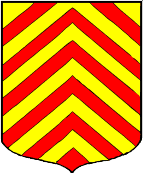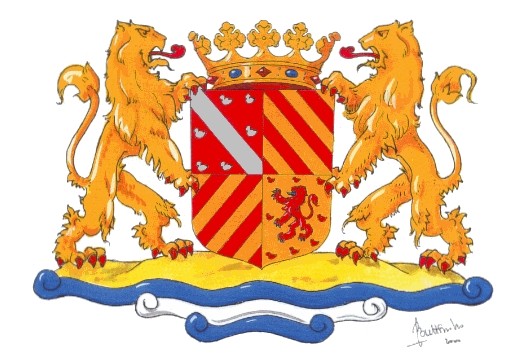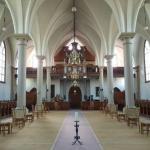
Kepers of gold and ‘throat’
The Egmond flag is based on the tribal coat of arms of the lords and counts of Egmond, which was already in vogue around the year 1200. It was characterized by twills of gold (yellow) and “throat,” or red. Throat is the heraldic color red that represents courage and sacrifice. Gold means wisdom and wealth.
Originally, the municipality of Egmond-Binnen, to which Egmond aan den Hoef also belonged, carried a coat of arms “of gold loaded with seven twillers of throat. Egmond aan Zee carried a coat of arms “of gold, laden with six twillers of throat. One less twill, in fact this was the only correct Egmont coat of arms, with as many twills as the tribal coat of arms.

The coat of arms for the new municipality of Egmond.
In 1978, the three Egmonden did not merge into the municipality of Egmond to everyone’s delight. On May 12, 1978, the new municipal council petitioned the Supreme Council of Nobility to obtain a new municipal coat of arms. With the application, they sent a preliminary design: a combination of the Egmond arms and the  coat of arms of Wimmenum, which has three moons.
coat of arms of Wimmenum, which has three moons.
The literal proposal is: a coat of arms: “of gold loaded with six twillers of throat and in the livery of sable loaded with three waxing moons of silver.” The Supreme Council of Nobility’s response proves rather surprising. Also for me, as I appear to have had a copy of that letter in my possession for years. A letter that rather stirs Egmond pride
The special letter from the Supreme Council of Nobility
How did I get that letter of June 8, 1978? Suddenly I remembered and stood in my mind’s eye in Jan Lute’s then-new historical library. The Egmond amateur historian who is sadly no longer among us had showered me with Egmond history and on going home gave me this remarkable copy which I then completely forgot about. Like no other, he realized the importance of that letter.
Now I was reading with redheads:
If one area is eligible to bear the coat of arms of the Counts of Egmond, or the Earldom of Egmond, it is the area created by merging the two municipalities of Egmond aan Zee and Egmond-Binnen.
For this reason, the council would like to advise you not to include the Wimmenum part in the new coat of arms etc.) Given the fact, that Egmond was one of the few counties in the Netherlands, the Council has no objection to consider this fact as a “special historical circumstance” in the sense of articles 5 and 6 of the 1977 guidelines.
The Council therefore proposes to you a crown of five leaves, considered a “higher” in the order of precedence of crowns than that of three leaves and two pearls, normally granted to public bodies. Also, the council has no objection to shield holders and would like to fall back on the seal of Charles, the third Count of Egmond (* 1541), one of the few images of the Counts of Egmond, on which shield holders appear. In conclusion, the council then arrived at a coat of arms whose description reads, “twinned of twelve pieces, gold and throat. The shield covered with a crown of five leaves and held by two facing lions of gold, tongued and nailed of throat.”
The new coat of arms of the 1978 municipality of Egmond
On June 23, 1978, Mayor A.G. Bakker addressed the council with a request to approve this. On Aug. 25, Queen Juliana grants her approval, and Home Affairs Minister Hans Wiegel also steps in. A stone bearing this coat of arms will be affixed to the former children’s colony house “Zwartendijk” because that is the new town hall for the merged municipality (In politically turbulent times called “De woeste Hoogte”). Thanks to an observant Egmond native, the stone has been saved from the dustbin and since 2007 can be found on the exterior wall of the Museum van Egmond in the Zuiderstraat in Egmond aan Zee
The merger with Bergen
In the 1990s, under the leadership of Mayor Brommet, the inevitability of a larger merger municipality was discussed. This has a lot going on in all the villages involved. Initially Egmond sees more in a merger with the municipality of Heiloo, but Heiloo does not want us. On Jan. 1, 2001, Bergen, Egmond and Schoorl merged. This under the express condition, that each village center is allowed to maintain its own character. At first it still seems that the new municipality will have a new name, but in the end it became municipality of Bergen. There also needs to be a new municipal coat of arms again there is much to do about that.

A new design
The draftsman of the Supreme Council of Nobility has made it something special again. Top left the coat of arms of Schoorl, bottom right that of Bergen. The critters on those arms are silver blackbirds without beaks and legs or “merlettes. The rest, of course, comes from the Egmond coat of arms. Egmond, after all, has a grave past? The whole stalwart stands on a foundation of rippling seawater and sand dunes.
Objections
But politicians have all sorts of objections. Is this design perhaps too Egmondian? And those lions, Egmond also only had them from 1978? Objections are also coming from Egmond because the rafters no longer form a whole. One would rather see at least the upper half of the shield become “Egmond” then. Jan Lute sticks it together like this. At the Supreme Council of Nobility, they are “not amused. Without much consultation, a much simpler weapon emerges. Would you like to know more about this? Read how a “Sudeten Derper” is still trying to save what can be saved and how the present coat of arms of the municipality of Bergen came about.
The Egmond flag
At Dekker bookstore, you can also buy the flag!
We go back in time. After the merger of the three Egmond districts in 1978, on December 18, 1980, it was also decided to have an official flag for the municipality of Egmond with 6 red rafters. The municipality orders only a few copies for official bodies. It is the crew of the
Pinck
who hung the flag at the top of the mast in 2007, touching the hearts of many Egmonders. Demand for the flag is coming in and the board of the Historic Egmond Foundation has the courage to order a thousand. The Historic Egmond Foundation is making it a campaign to mark its 15th anniversary in 2008 and also hopes to recruit many new donors (who will receive the flag at a discount). Starting in May 2008, the Egmond flag will be for sale at a few addresses in Egmond and at the market during village festivals. The intention is to fly the red and yellow from now on during festivities in the three Egmond areas such as the marathon, the Art Market, the Hoever Village Festival, the Fishing Day and Egmond op zijn Kop. From the reactions and the large number of orders, the Egmond feeling is alive and well! To order the Egmond flag, please click here to go to the order form.
You will therefore understand that on Fishing Day, in a Derper lecture, those precious Egmond lions are sometimes spoken of with melancholy….
The final coat of arms of the municipality of Bergen: On July 9, 2001, Queen Beatrix approved the new coat of arms of the municipality of Bergen after advice from the High Council of Nobility. The accompanying diploma lists the weapon, the cost of € 390 and the following description:
“Notched of four pieces of throat and gold and eight sun-set merlettes of silver and throat. The shield covered with a gold crown of five leaves”.
Notable in this new coat of arms is the absence of the lions and thus the pedestal with the symbolic representation of the dunes and the sea. The five-leaf crown, somewhat richly depicted, does recall Egmond’s grave past. Of the 12 twillers of throat and gold of the coat of arms of Egmond, four now remain, but larded with Schoorl and Bergen merlettes, the ducks without beaks and legs. So from now on the people of Egmond will have to make do with merlettes instead of lions, and it is easy to guess how that will be thought of.
Incidentally, there is still sometimes confusion about the correct weapon. The rejected coat of arms appears to have remained on the Bergen County website for years. Also on other Internet pages is (or was when this article was written in 2007 ) the rejected and not the new weapon. Is it perhaps because people actually like the first weapon better than what it ended up being? And what did the (same) illustrator himself think of it? He did not put his signature under this new coat of arms, but only an initial.







